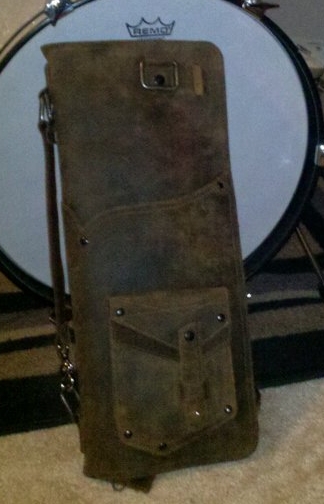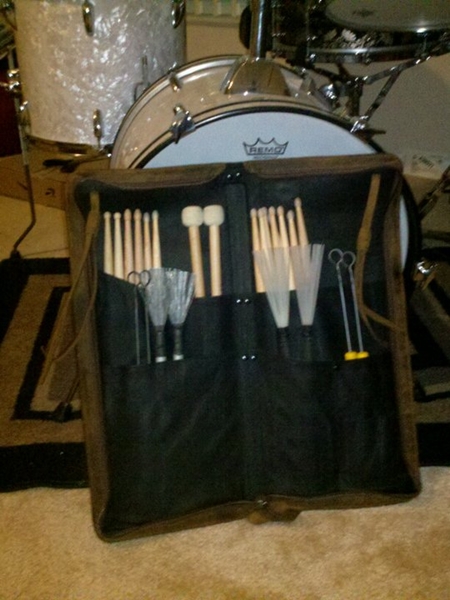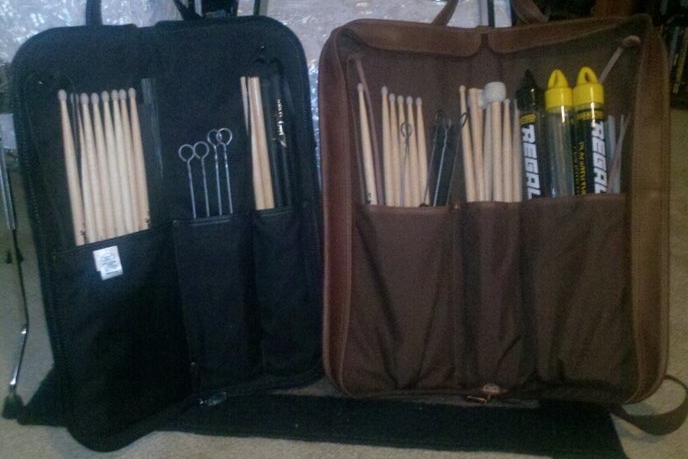- Regal Tip Jeff Hamilton brushes
- Regal Tip BR-594P Ed Thigpen Plastic Brushes
- Regal Tip 550W Drum Brushes
- Regal Tip 561A Aluminum Handle Brushes
- Regal Tip 583R Brushes
- Regal Tip JR John "JR" Robinson Brushes
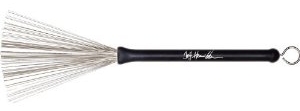
The reason I find this particular model interesting is I started out playing lighter and thinner brushes (handle size, not wires), and have grown to love heavier models. Compared to the competing and popular Vic Firth Heritage Brush this brush is noticeably heavier and a tad thicker. The wires are a heavier gauge on this one, which is a plus for me (another change in my preferences over time.)
Another plus for these brushes is the pull rod stays in whichever position you place it. I often will pull back on my right brush to reduce the fan, leaving the left brush's fan full. The pull rods on some brush brands will start pushing as you play, further reducing the fan and distracting you when you should be concentrating on playing. This model will not do that. In fact, the reason I am so loyal to Regal Tip for brushes is none of their retractable models cause problems that I have experienced with other brands.
Next up is the Regal Tip BR-594P Ed Thigpen Plastic Brushes, which look more like rods than brushes. They are, however, brushes.

I first saw these in action while watching and working through The Essence of Brushes (DVD). I immediately purchased a pair and practiced some of the grooves.
What sets these apart from the so-called rods that many drummers use is you can get a good swish sound from rods. Nor can you get any legato sound from them. I do not use rods for that reason (and never will - I think they were designed for drummers who have no dynamic range), but these are simply amazing. Depending on where you have the rubber ring that controls the spread of the bristles, you can get some very staccato sounds, or more slap like sounds. Be aware, though, that these will not fan out like regular brushes.
Although I do not often use them live because the music I normally play does not call for them, I keep a pair in my stick bag.
The Regal Tip 550W Drum Brushes is an interesting pair of fixed brushes that are great for some types of music.
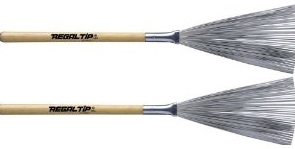
Although I prefer retractable brushes I do use this one. The reason I started using this model for some playing situations is the taps are full and the sweeps have a sound quality I cannot get from my favorite brushes. Also, the thin handle (I am sure it's not over .5 inches in diameter) allows me to effortlessly sweep in a larger pattern for faster tempos, something that a heavier, multi-purpose brush will not do well.
Interestingly, the bristles are super thin (compared to other models in the Regal Tip line), which may account for the speed with which they can be swept across a head in a relatively wide arc during fast tempo songs. The bristles are about on par with the Yellow Jacket retractable model that I discussed in Part 1. The overall brush responds quicker because of the thin and light, fixed wood handle.
These brushes do not always come with me when I am playing. I have a bag that accommodates the plastic tubes fixed brushes ship in for playing situations that I know are going to be jazz only.
I'd love to say that I've never met a brush that I didn't like. While I don't hate the Regal Tip 561A Aluminum Handle Brush model, I am not overly fond of it.
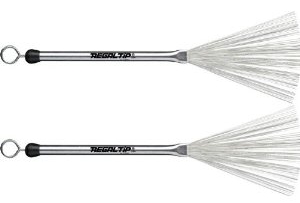
Even though I personally do not care for this brush model, I am giving it five stars for the following reasons: (1) brushes - like sticks - are personal and choosing models that fit your personal style does not mean the ones you did not select are necessarily bad or inferior. (2) These brushes are very well constructed, and (3), the aluminum handles may appeal to some who have played some of the similar brushes from yesteryear.
What makes them interesting is the handle diameter, which is an anemic .437". I love thin sticks and handles, but this is too thin for even my tastes. In fact, this brush model is even thinner than the Regal Tip Combo sticks, which are probably the thinnest sticks on the market at .485" diameter. This is not a show stopper since there are drummers who subscribe to the 'thinner is better' philosophy. Not too many years ago I was among them - and still use very thin sticks compared to many.
For me the deal breaker is the aluminum handle. Yes, you can do a lot with them, including cross-stick patterns. However, it gets awfully slippery very quickly. That can be remedied by wrapping it in tape, but that defeats the purpose in my opinion. Still, that is my observation, and many vintage brushes were made with metal handles, so some folks will find that feature attractive.
These are not for everybody, but if you find them appealing I can assure you that they are very well constructed and should last a long time if you take care of them. And if you have small hands these may be the perfect brush for you.
The Regal Tip 583R Brushes are probably the most played brushes in the world. They don't look special, but they are meat and potatoes tools for brush players.
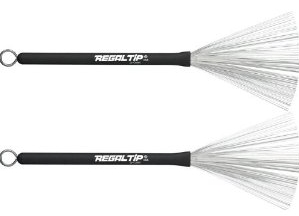
I normally carry multiple brush models in my stick bag. However, if I could only bring a single pair of brushes, these would be the ones.
The wire bristles are medium weight, providing a consistent sound and feel across tempo and dynamic ranges. The handles are comfortable and lightweight, and if you familiar if you play other Regal Tip models. I have never experienced any issues with these brushes marring heads that were reported by others.
I adjust the fan of my right brush to obtain the dynamic level appropriate for each song, as well as to achieve the staccato or legato level I want. Therefore, any brush that has a retractable handle that does not stay put quickly falls out of favor with me. This one does not. I keep a few pairs in my practice space and in my car.
As I said, they are not my go-to brushes, but they are ones I keep around because they are versatile and relatively inexpensive.
The final model I'll cover in this post is the Regal Tip JR John "JR" Robinson Brushes.

This brush is based on the Regal Tip 583R above. What Regal Tip did was lengthen the handle of what I call a 'meat & potatoes' brush, changing the feel and (in my opinion) improving the already superb balance.
Like the 583R, the wire bristles are medium weight and gives a consistent sound and feel across tempo and dymamic ranges. Moreover, the retractable handle stays in any position without budging. This is important to me because I adjust the fan of my right brush to obtain the dynamic level appropriate for each song, as well as to achieve the staccato or legato level I want.
While this model does not have the long-handle feel of the Clayton Cameron model that I discussed in Part 1, the extra length makes it a pleasure for me to use. This is a personal preference that reflects my own playing habits - others may have valid reasons for not liking it.
I'll continue with a Part 3 at a later time. In the mean time, there is a wealth of information about brushes and brush playing in this blog. There also some relevant topics in my Music For Drummers blog. A parting word: when shopping for brushes, bear a few things in mind:
- Feel and balance, and even retractable vs. fixed are considerations you need to take into account. That means it is always better to actually hold and try before buying.
- It is OK to have and use more than one model (or even brand.) If you find two models you like and cannot decide, get both if your budget allows it.
- Once you settle on model(s) become intimately familiar with them, their playing characteristics, and strengths and weaknesses.

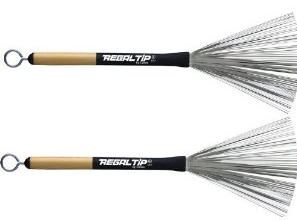
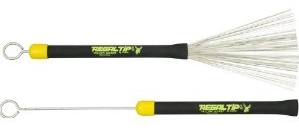
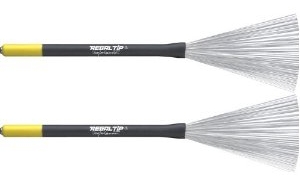
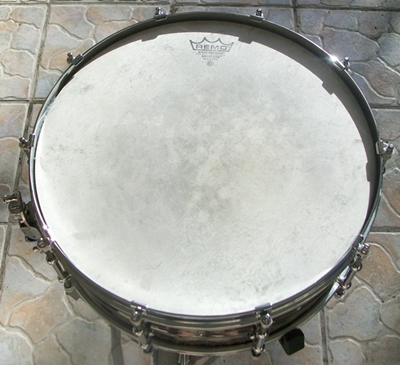




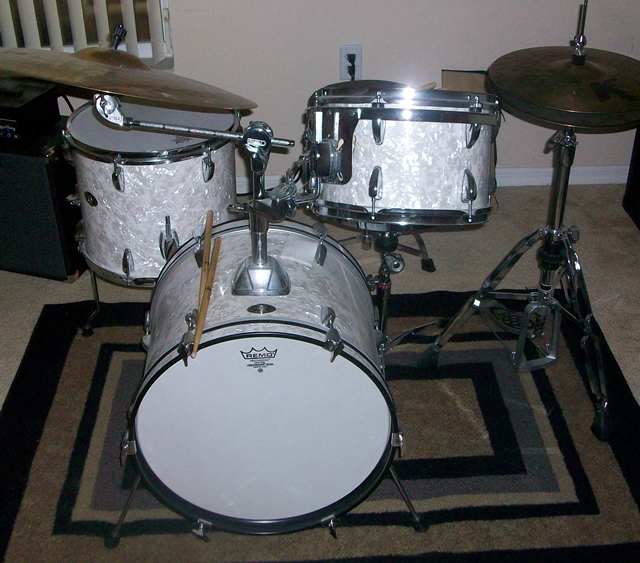
 The Snare drum is a very unique one that was custom made using 1930s Radio King parts and a magnesium shell. The engraved hoops required Aquarian American Vintage heads
The Snare drum is a very unique one that was custom made using 1930s Radio King parts and a magnesium shell. The engraved hoops required Aquarian American Vintage heads 
